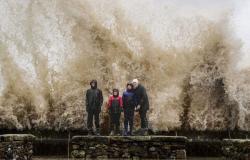Tuesday, November 12, drinking water will be distributed in the schools of Saint-Laurent du Maroni, promises the rector of Guyana. Philippe Dulbecco wants to reassure in the face of drought. He welcomes the end of student transport operations, and organizes educational continuity.
Guyana has been facing a rain deficit for 18 months and an unprecedented drought. Residents have to deal with rivers at their lowest levels, river transport at a standstill and access to drinking water restricted in places.
In schools, students and teachers are also adapting. Faced with the salt wedge episode announced in Saint-Laurent du Maroni, the rector of the Academy of Guyana ensures that drinking water will be distributed in educational establishments.
From this Tuesday, November 12, “the schools, middle schools and high schools of Saint-Laurent du Maroni will be or will have been supplied with drinking water so that neither the staff nor the students can suffer from this situation”promet Philippe Dulbecco.
During tidal periods, water salinity conditions can be affected and make the water unfit for consumption. The rector assures that the situation was anticipated. “Middle and high schools have already received 52 pallets of drinking water, or 40,000 bottles of water, thanks to the action of the Territorial Collectivity of Guyana and the city.he adds. For schools, Philippe Dulbecco announces that drinking water is already in Saint-Laurent du Maroni and that it will be distributed this Tuesday.
“Insufficient”, estimate STEG-UTG, education union in Guyana which requests the closure of establishments in Saint-Laurent du Maroni.
The rector of Guyana also announces a protocol on “what to do in the event of water cuts in schools”. “It should be communicated at the beginning of the week,” he adds.
Faced with the drop in the level of rivers, and in particular the Maroni, the rector of the Academy of Guyana is delighted that all the transports of students and teachers have been carried out. Last week, PUMA helicopters from the Armed Forces of Guyana were requisitioned to transport students from Trois-Sauts to Camopi.
Flights were also chartered by the Community and the Academy of Guyana. For their part, mayors had made canoes available to cover the last miles.
“This operation is last for us”, is satisfied Philippe Dulbecco, who nevertheless says to himself “pay attention to the transport of students by canoe”. For example, students from Loca and Boniville currently take one hour instead of 40 minutes to travel by canoe to reach their college in Papaïchton. The journey has become longer and more complicated for the canoeists who do not know how long they will still be able to complete it.
Depending on the evolution of river levels, if these transports were interrupted, the rector of Guyana assures that “Measures will be taken to ensure educational continuity.”
This is already the case for the students of the Antecum Pata and Pidima schools, now inaccessible by canoe. Educational continuity is in place for the students of Trois-Sauts and in certain areas of Apatou and Maripasoula, assures the rector.
Guyana is experiencing an exceptional dry season. The ORSEC water plan was launched by the prefecture on October 29.






